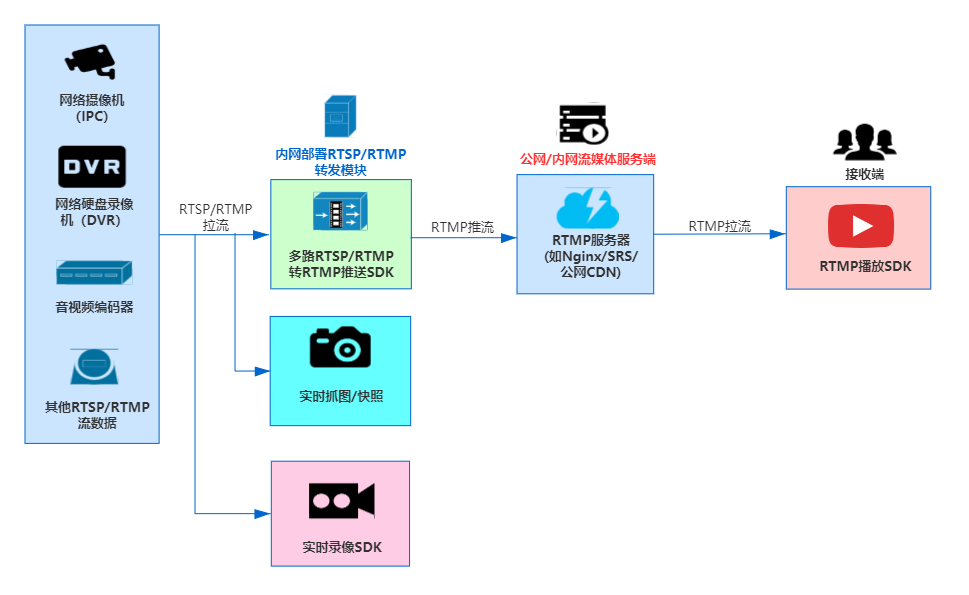一个好的转发模块,首先要低延迟!其次足够稳定、灵活、有状态反馈机制、资源占用低,跨平台,最好以接口形式提供,便于第三方系统集成。
以Windows平台为例,我们的考虑的点如下
1. 拉流:通过RTSP直播播放SDK的数据回调接口,拿到音视频数据;
2. 转推:通过RTMP直播推送SDK的编码后数据输入接口,把回调上来的数据,传给RTMP直播推送模块,实现RTSP数据流到RTMP服务器的转发;
3. 录像:如果需要录像,借助RTSP直播播放SDK,拉到音视频数据后,直接存储MP4文件即可;
4. 快照:如果需要实时快照,拉流后,解码调用播放端快照接口,生成快照,因为快照涉及到video数据解码,如无必要,可不必开启,不然会额外消耗性能。
5. 拉流预览:如需预览拉流数据,只要调用播放端的播放接口,即可实现拉流数据预览;
6. 数据转AAC后转发:考虑到好多监控设备出来的音频可能是PCMA/PCMU的,如需要更通用的音频格式,可以转AAC后,在通过RTMP推送;
7. 转推RTMP实时静音:只需要在传audio数据的地方,加个判断即可;
8. 拉流速度反馈:通过RTSP播放端的实时码率反馈event,拿到实时带宽占用即可;
9. 整体网络状态反馈:考虑到有些摄像头可能会临时或异常关闭,RTMP服务器亦是,可以通过推拉流的event回调状态,查看那整体网络情况,如此界定:是拉不到流,还是推不到RTMP服务器。
系统设计架构图
Windows转发demo分析
大牛直播SDK的转发demo,Windows平台,对应C++ demo工程:WIN-RelaySDK-CPP-Demo,如需下载demo源码,参看 Github
1. 拉流:拉流和播放有些类似,但不需要播放(也就是说不要解码,资源消耗非常低),在做过基础的参数配置之后(对应demo里面OpenPullHandle()),设置音视频数据回调,然后调用StartPullStream()即可:
1.1 基础参数设置:
1.2 设置音视频数据回调:
1.3 开始拉流:
拉流整体代码如下:
2. 停止拉流:
停止拉流流程比较简单,先判断是否在拉流状态,如果拉流,调用StopPullStream() 即可,如没有预览画面,调用Close()接口关闭拉流实例。
3. 拉流端预览:
拉流端预览,说白了就是播放拉流数据,流程比较简单,demo调用如下,如不需要播放声音,调用SetMute(),实时打开/关闭即可:
4. 拉流端关闭预览:
5. 开始推流到RTMP服务器:
推流的流程,如之前所述,调用RTMP推送模块,然后数据源传编码后的音视频数据即可,下图的demo源码,同时展示了,RTSP流获取到后,转推RTMP的时候,数据解密的处理:
6. 传递转推RTMP数据:
7. 关闭实时RTMP转推
以上就是RTSP或RTMP流转RTMP推送的流程,感兴趣的开发者,可做设计参考。
